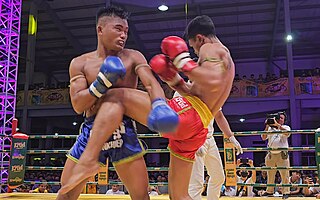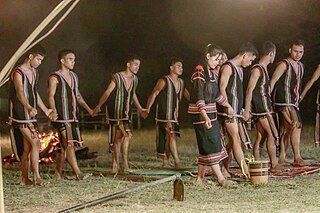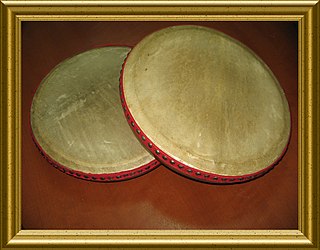
Southeast Asia is the geographical southeastern region of Asia, consisting of the regions that are situated south of China, east of the Indian subcontinent, and northwest of the Australian mainland, which is part of Oceania. Southeast Asia is bordered to the north by East Asia, to the west by South Asia and the Bay of Bengal, to the east by Oceania and the Pacific Ocean, and to the south by Australia and the Indian Ocean. Apart from the British Indian Ocean Territory and two out of 26 atolls of the Maldives in South Asia, Maritime Southeast Asia is the only other subregion of Asia that lies partly within the Southern Hemisphere. Mainland Southeast Asia is entirely in the Northern Hemisphere. East Timor and the southern portion of Indonesia are the parts of Southeast Asia that lie south of the equator.

The music of Cambodia is derived from a mesh of cultural traditions dating back to the ancient Khmer Empire, India, China and the original indigenous tribes living in the area before the arrival of Indian and Chinese travelers. With the rapid Westernization of popular music, Cambodian music has incorporated elements from music around the world through globalization.

Kun Khmer, or Pradal Serey, is a combat sport that originated in Cambodia. The sport consists of stand up striking and clinch fighting, where the objective is to knock an opponent out, force a technical knockout, or win a match by points. The sport was codified in Cambodia by the French colonial administration in the early 20th century, and was derived from centuries-old traditions, namely Bokator, the close-quarter combat system used during the Khmer empire. The official Khmer name of the sport is Kbach Kun Pradal Khmer.

Romvong, Lamvong or Ramwong, Rambung, Vietnamese: lăm-vông) is a type of Southeast Asian dance where both females and males dance in a circle. It is a popular folk-dance in Cambodia, Laos, Malaysia, Xishuangbanna (China), and Thailand. It is a slow round dance continuously moving in a circular manner, and incorporates graceful hand movements and simple footwork. Both men and women participate in the same circle.

The Khmer people are an Austroasiatic ethnic group native to Cambodia. They comprise over 95% of Cambodia's population of 17 million. They speak the Khmer language, which is part of the larger Austroasiatic language family alongside Mon and Vietnamese.
A Living Human Treasure is, according to UNESCO, a person who possesses to a high degree the knowledge and skills required for performing or re-creating specific elements of the intangible cultural heritage. This title or a form of it is awarded by the nation's government to a person who is regarded as a national treasure while still alive. The title is also known as Living National Treasure.

The rebana or terbangan is a tambourine that is used in Islamic devotional music in Southeast Asia, particularly in Indonesia, Malaysia, Brunei, and Singapore. The sound of the rebana often accompany Islamic ritual such as the zikir. The name rebana came from the Arabic word robbana. The rebana is also used by the Cham people of Cambodia and also gave rise to the Rabana which is used by the Sinhalese people of Sri Lanka.

Jarai people or Dega are an Austronesian indigenous people and ethnic group native to Vietnam's Central Highlands, as well as in the Cambodian northeast Province of Ratanakiri. During the Vietnam War, many Jarai persons, as well as members of other Montagnard groups, collaborated with US Special Forces, and many were resettled with their families in the United States, particularly in North Carolina, after the war.

The tro is Cambodia's traditional spike fiddle, a bowed string instrument that is held and played vertically. Spike fiddles have a handle that passes through the resonator, often forming a spike, on the bottom side where it emerges. The family is similar or distantly related to the Chinese erhu or huqin. The instruments have a soundbox at the bottom of the stick, covered with leather or snake skin. Strings run from pegs at the top of the stick and secured at the bottom, running across the soundbox. The larger the soundbox, the lower the pitch range. Instruments in this family include the two-stringed tro ou, tro sau thom, tro sau toch and tro che, as well as the three-stringed tro Khmer spike fiddle. The two-stringed tros are tuned in a fifth, while the three-stringed tro Khmer is tuned in fourths. The tros, with the exception of the tro Khmer, are strung so that the bowstring is permanently placed between the two stings. When the musician plays, the placement of the bow causes the strings to be played at once, one from below and one from above. In contrast, western fiddles are played with the bow pushing on each string from the outside, as is also the case with the tro khmer.

Dance in Thailand is the main dramatic art form in Thailand. Thai dance can be divided into two major categories, high art and low art.
Yike is a prominent form of Cambodian musical theater, along with Bassac theater and Niyeai. "Lakhon Yike" incorporates singing and dancing and "an ensemble of both traditional and modern instruments."

The Chapei Dang Veng or chapey (ចាប៉ី) is a Cambodian two-stringed, long-necked guitar that is usually plucked.

The thon and rammana are hand drums played as a pair in Khmer and Thai classical music. It consists of two drums: the thon, a goblet drum with a ceramic or wooden body and the rammana, a small rebana-typed frame drum or tambourine. They are used usually in the Mohaori ensemble in Cambodia and khruang sai ensemble in Thailand. The thon gives a low pitch and the rammana gives a high pitch. Earlier in the 20th century, the thon and rammana were sometimes played separately.

Lakhon Khol or Khmer Masked Theatre is a dance drama genre that is performed in Cambodia.
The traditional martial arts of the Mainland Southeast Asia are related to one another, and as a group to Indian martial arts. The most salient common feature is Mainland Southeast Asia kickboxing. The region of Mainland Southeast Asia is believed to be the land of Suvarnabhumi that ancient Indians mentioned in Buddhist text and Hindu text. In 790 A.D., a Khmer prince who grew up abroad by the name of Jayavarman II returned to unify the Khmer civilization. In 802 A.D., Jayavarman II established the Khmer Empire, the precursor to modern Cambodia, and declared himself the Chakravatin. Around 850 A.D., Pagan, the ancestor of modern-day Burma, was established by Tibeto-Burman speakers. For 200 years, Pagan remained a small principality until the reign of King Anawrahta. In 1238 A.D., Thailand's first state, Sukhothai, was started when the residents declared independence from the Khmer Empire. In 1353 A.D., Laos's first state, Lan Xang, was started by Fa Ngum with the assistance of the Khmer from Angkor.

Roneat is the generic Khmer word for referring to several types of xylophones used in traditional Cambodian music; the pinpeat and mohaori.

The Skor thom are Cambodian 2-headed barrel drums played with a pair of wooden drumsticks. They typically have skin heads made from oxen, cows or buffalos, and are played in pairs. The drums are tuned such that one will give a "tighter and louder" sound when struck, while the other gives a "loose and more flatter tone." The log is hollowed out to form a thin tube, about 1 centimeter thick, and the hide is stretched out on each side to create the drum. Dimensions for the instruments vary, as they are carved from logs; however they can measure 50 centimetres long and be 46 centimetres in across at the center of the drum, with the ends being about 40 centimetres wide.

Kompang is a traditional Balinese and Javanese musical instrument part of gamelan in the percussion family originated from the Indonesian region of Ponorogo in East Java. Kompang has existed in Indonesia since at least the 8th century and has spread to various regions of Indonesia as well as the Southeast Asia in general, such as Singapore, Malaysia, Brunei and Thailand, which later became known as Kompang Jawa.
Tugging rituals and games are four cultural practices in Cambodia, Philippines, South Korea, and Vietnam, which were collectively included in UNESCO's Intangible Cultural Heritage of Humanity List in 2015. The tugging rituals and games, namely lbaengteanhprot, punnuk, juldarigi, and keo co, include two teams, with each pulling one end of a rope, attempting to tug it from the other.
















